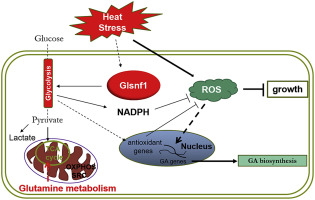当前位置:
X-MOL 学术
›
Free Radical Bio. Med.
›
论文详情
Our official English website, www.x-mol.net, welcomes your feedback! (Note: you will need to create a separate account there.)
Glsnf1-mediated metabolic rearrangement participates in coping with heat stress and influencing secondary metabolism in Ganoderma lucidum.
Free Radical Biology and Medicine ( IF 7.4 ) Pub Date : 2019-12-26 , DOI: 10.1016/j.freeradbiomed.2019.12.041 Yanru Hu 1 , Wenzhao Xu 1 , Shishan Hu 1 , Lingdan Lian 1 , Jing Zhu 1 , Ang Ren 1 , Liang Shi 1 , Ming Wen Zhao 1
Free Radical Biology and Medicine ( IF 7.4 ) Pub Date : 2019-12-26 , DOI: 10.1016/j.freeradbiomed.2019.12.041 Yanru Hu 1 , Wenzhao Xu 1 , Shishan Hu 1 , Lingdan Lian 1 , Jing Zhu 1 , Ang Ren 1 , Liang Shi 1 , Ming Wen Zhao 1
Affiliation

|
The AMP-activated protein kinase (AMPK)/Sucrose-nonfermenting serine-threonine protein kinase 1 (Snf1) plays an important role in metabolic remodelling in response to energy stress. However, the role of AMPK/Snf1 in responding to other environmental stresses and metabolic remodelling in microorganisms was unclear. Heat stress (HS), which is one important environmental factor, could induce the production of reactive oxygen species and the accumulation of ganoderic acids (GAs) in Ganoderma lucidum. Here, the functions of AMPK/Snf1 were analysed under HS condition in G. lucidum. We observed that Glsnf1 was rapidly and strongly activated when G. lucidum was exposed to HS. HS significantly increased intracellular H2O2 levels (by approximately 1.6-fold) and decreased the dry weight of G. lucidum (by approximately 45.6%). The exogenous addition of N-acetyl-l-cysteine (NAC) and ascorbic acid (VC), which function as ROS scavengers, partially inhibited the HS-mediated reduction in biomass. Adding the AMPK/Snf1 inhibitor compound C (20 μM) under HS conditions increased the H2O2 content (by approximately 2.3-fold of that found in the strain without HS treatment and 1.5-fold of that found in the strain under HS treatment without compound C) and decreased the dry weight of G. lucidum (an approximately 28.5% decrease compared with that of the strain under HS conditions without compound C). Similar results were obtained by silencing the Glsnf1 gene. Further study found that Glsnf1 meditated metabolite distribution from respiration to glycolysis, which is considered a protective mechanism against oxidative stress. In addition, Glsnf1 negatively regulated the biosynthesis of GA by removing ROS. In conclusion, our results suggest that Glsnf1-mediated metabolic remodelling is involved in heat stress adaptability and the biosynthesis of secondary metabolites in G. lucidum.
中文翻译:

Glsnf1介导的代谢重排参与应对热应激并影响灵芝的次级代谢。
AMP激活蛋白激酶(AMPK)/非蔗糖发酵丝氨酸-苏氨酸蛋白激酶1(Snf1)在响应能量压力的代谢重塑中起重要作用。但是,尚不清楚AMPK / Snf1在响应其他环境压力和微生物代谢重塑中的作用。作为重要的环境因素,热应激(HS)可以诱导灵芝中活性氧的产生和灵芝酸(GAs)的积累。在这里,在灵芝中在HS条件下分析了AMPK / Snf1的功能。我们观察到,当灵芝暴露于HS时,Glsnf1被迅速而强烈地激活。HS显着增加了细胞内H2O2的水平(大约1.6倍),降低了灵芝的干重(大约45.6%)。N-乙酰基-1-半胱氨酸(NAC)和抗坏血酸(VC)的外源添加(其功能是ROS清除剂)部分抑制了HS介导的生物量减少。在HS条件下添加AMPK / Snf1抑制剂化合物C(20μM)会增加H2O2含量(约为未经HS处理的菌株的2.3倍,是未经化合物C经过HS处理的菌株的1.5倍),降低了灵芝的干重(与不含化合物C的HS条件下的菌株相比,降低了约28.5%)。通过沉默Glsnf1基因获得了相似的结果。进一步的研究发现,Glsnf1可调节代谢产物从呼吸到糖酵解的分布,这被认为是抗氧化应激的一种保护机制。此外,Glsnf1通过去除ROS负调控GA的生物合成。总之,我们的结果表明,Glsnf1介导的代谢重塑与热应激适应性和灵芝次生代谢产物的生物合成有关。
更新日期:2019-12-27
中文翻译:

Glsnf1介导的代谢重排参与应对热应激并影响灵芝的次级代谢。
AMP激活蛋白激酶(AMPK)/非蔗糖发酵丝氨酸-苏氨酸蛋白激酶1(Snf1)在响应能量压力的代谢重塑中起重要作用。但是,尚不清楚AMPK / Snf1在响应其他环境压力和微生物代谢重塑中的作用。作为重要的环境因素,热应激(HS)可以诱导灵芝中活性氧的产生和灵芝酸(GAs)的积累。在这里,在灵芝中在HS条件下分析了AMPK / Snf1的功能。我们观察到,当灵芝暴露于HS时,Glsnf1被迅速而强烈地激活。HS显着增加了细胞内H2O2的水平(大约1.6倍),降低了灵芝的干重(大约45.6%)。N-乙酰基-1-半胱氨酸(NAC)和抗坏血酸(VC)的外源添加(其功能是ROS清除剂)部分抑制了HS介导的生物量减少。在HS条件下添加AMPK / Snf1抑制剂化合物C(20μM)会增加H2O2含量(约为未经HS处理的菌株的2.3倍,是未经化合物C经过HS处理的菌株的1.5倍),降低了灵芝的干重(与不含化合物C的HS条件下的菌株相比,降低了约28.5%)。通过沉默Glsnf1基因获得了相似的结果。进一步的研究发现,Glsnf1可调节代谢产物从呼吸到糖酵解的分布,这被认为是抗氧化应激的一种保护机制。此外,Glsnf1通过去除ROS负调控GA的生物合成。总之,我们的结果表明,Glsnf1介导的代谢重塑与热应激适应性和灵芝次生代谢产物的生物合成有关。


























 京公网安备 11010802027423号
京公网安备 11010802027423号